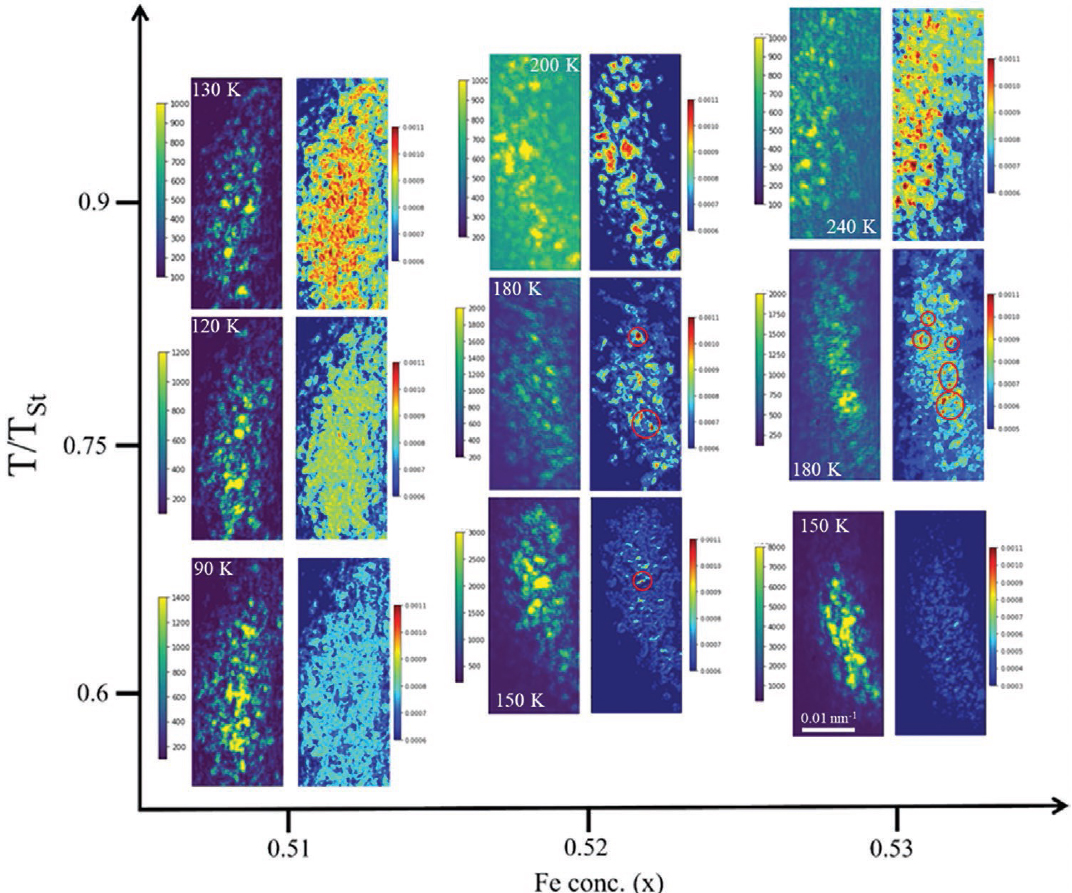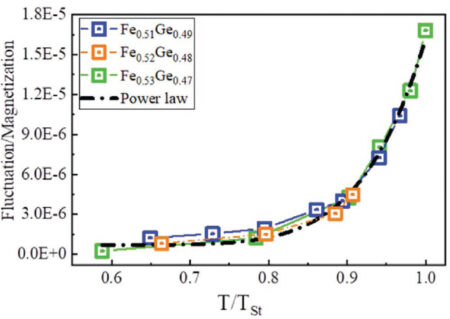SCIENTIFIC ACHIEVEMENT
Using the Advanced Light Source (ALS), researchers discovered that nanoscale spin fluctuations deep inside ordered states of a magnetic film can characterize phase transitions, independent of underlying magnetic interactions.
SIGNIFICANCE AND IMPACT
The results provide a new path to predicting and understanding phase transitions in materials relevant to high-density, energy-efficient microelectronics.

Materials going through a phase
Phase transitions, such as the rearrangement of molecules in a liquid crystal display or the onset of superconductivity at low temperature, are key to technologies that rely on functional material properties. Many phase transitions are triggered by thermal fluctuations of atoms and molecules. The ability to tailor these fluctuations could lead to new phases of matter relevant to, for example, spintronic applications for highly compact, energy-saving devices. However, the collective effects of tiny thermal jiggles in large ensembles of particles are incredibly difficult to model using first principles.
In this work, researchers used dynamic soft x-ray scattering data (speckle patterns) to study how nanoscale thermal fluctuations give rise to a phase transition in a magnetic thin film. Their analysis revealed a simple formula that signals the onset of a phase transition, irrespective of the system’s microscopic details.
Fingerprinting Fe-Ge films
The researchers studied an amorphous iron germanium (Fe-Ge) magnetic thin film that exhibits stripe domains with helical spin texture. As the temperature or the iron content increases, the material undergoes a phase transformation to a paramagnetic state, where the spins align only in an external magnetic field.
Coherent x-ray diffraction patterns arising from the helical stripe phase consist of a large number of speckles because of the non-homogeneity (periodicity and orientation) of the stripe domains in real space. The observed speckle pattern is a fingerprint of the domain morphology, and changes in the speckle pattern indicate changes in morphology.
First quantum-material study at COSMIC
At ALS Beamline 7.0.1.1 (COSMIC Scattering), the researchers used resonant and coherent x-ray scattering tuned to the Fe L3 edge. Resonant x-ray scattering measurements are sensitive to static magnetic structure and spatial correlation length (the spatial extent of fluctuations at a given point in time), while coherent x-ray scattering enables time-dependent measurements.
Notably, this is the first study of a quantum material done at the COSMIC scattering branch, which has an endstation specifically for fluctuation studies. It involved a close collaboration between the ALS and the Non-Equilibrium Magnetic Materials (NEMM) program, based in the Materials Sciences Division of Berkeley Lab.

Seeds of chaos within order

The results showed that the origin of the helical-to-paramagnetic phase transition lies in the appearance of areas of enhanced fluctuation, or “hot spots,” deep within ordered regions. The hot spots depend on Fe concentration and appear randomly at low temperatures in a small fraction of domains. Close to the phase transition, all domains start to fluctuate randomly for all Fe concentrations. The fluctuating fraction, when normalized to magnetization for different Fe concentrations, was found to follow a single power-law behavior, suggesting that the nature of the transition can be described in terms of the underlying spatio-temporal fluctuations.
Controlling and tailoring the fluctuating fraction could lead to new phase-transition pathways and possibly new phases of matter. Furthermore, this methodology can be applied to other systems exhibiting fluctuation—biological and social science phenomena, for example, where models of how various conditions contribute to certain outcomes (growth models) are often used to predict the emergence new species and catastrophic events.
Contact: Sujoy Roy
Researchers: A. Singh (Berkeley Lab); E. Hollingworth and F. Hellman (Berkeley Lab and UC Berkeley); S.A. Morley, A. Us Saleheen, M. McCarter, S.D. Kevan, and S. Roy (ALS); X.M. Chen (Berkeley Lab and Brookhaven National Laboratory); and R. Tumbleson and P. Fischer (Berkeley Lab and UC Santa Cruz).
Funding: Materials Sciences and Engineering Division and Scientific User Facilities Division of the US Department of Energy, Office of Science, Basic Energy Sciences Program (DOE BES); Laboratory Directed Research and Development program (Berkeley Lab). Operation of the ALS is supported by DOE BES.
Publication: A. Singh, E. Hollingworth, S.A. Morley, X.M. Chen, A. Us Saleheen, R. Tumbleson, M. McCarter, P. Fischer, F. Hellman, S.D. Kevan, and S. Roy, “Characterizing Temporal Heterogeneity by Quantifying Nanoscale Fluctuations in Amorphous Fe-Ge Magnetic Films,” Adv. Funct. Mater. 33, 2300224 (2023); doi:10.1002/adfm.202300224.
ALS SCIENCE HIGHLIGHT #489